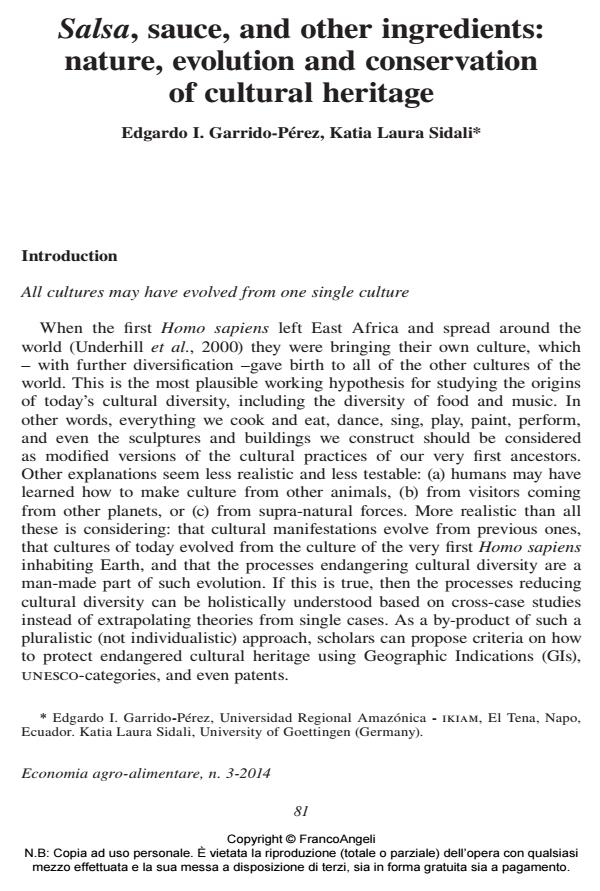Salsa, sauce, and other ingredients: nature, evolution and conservation of cultural heritage
Journal title ECONOMIA AGRO-ALIMENTARE
Author/s Edgardo I. Garrido-Pérez, Katia Laura Sidali
Publishing Year 2014 Issue 2014/3
Language English Pages 24 P. 81-104 File size 177 KB
DOI 10.3280/ECAG2014-003007
DOI is like a bar code for intellectual property: to have more infomation
click here
Below, you can see the article first page
If you want to buy this article in PDF format, you can do it, following the instructions to buy download credits

FrancoAngeli is member of Publishers International Linking Association, Inc (PILA), a not-for-profit association which run the CrossRef service enabling links to and from online scholarly content.
All cultural manifestations in the world, including food and music, derived from the cultural practices developed by the first Homo sapiens who inhabited the Earth. But, with so many cultural manifestations, which ones need protection? Should the same theory be adopted as the one which seems to be used by Geographic Indication systems and other forms of protection? How does cultural diversification occur? How do cultural manifestations increase, spread, or decline and how can such a decline be avoided? How does one detect whether a product is an example of cultural heritage to be protected and not a mere fashion or creation of single individuals? Here we discuss the nature of cultural heritage by answering these questions for Afro-Caribbean music and culinary art. At the same time, we reveal some misconceptions regarding evolution attributable to Biology, and which have been largely neglected by Biologists while being kept alive by some social scientists (e.g. social Darwinists). Cultural heritage studies used to extrapolate general theories from single case studies, have generated too many theories based on poor evidence. We, on the other hand, rather more coherently, bring together more than 80 examples of music and food into one single theory, able to be tested and perheps improved upon by further research. Six characteristics and principles of the theory are derived from the fact that cultural heritage is passed down from one generation to the next: (1) Conservative reproduction, (2) intra-generational variability, (3) transformation over time, (4) exposure to forces causing trends to proliferation - and decline, (5) exposure to forces leading to territorial expansion - and contraction, and (6) rise of new culture from previous ones. We provide examples of how a new cultural heritage can arise from previous ones by means of: (a) mingling with ther cultural heritage of other peoples, (b) unforseen innovation by creative individuals, and (c) geographically mediated differentiation. Inventions made by single individuals or families and non-inherited from previous generations are not to be considered "heritage" and should be protected under other denominations. Cultural manifestations that suffer a decline in practitioners through the generations need to be protected by means of legal, technical, educational, and even marketing practices gaining acceptance from the new generations who should be considered the key to the preservation of any heritage.
Keywords: Afro-Caribbean music, cultural evolution and diversification, food specialties, geographical indications, meme-theory
Jel codes: D12
- Guest editorial. Revisiting the Slow Food Movement: Three Cases of Heritage, Innovation, and Sustainability in Alternative Food Networks Luca Cacciolatti, Soo Hee Lee, Giovanna Sacchi, Jinha Lee, in Economia agro-alimentare 2/2024 pp.83
DOI: 10.3280/ecag2024oa18190 - Creative Cities of Gastronomy: Towards relationship between city and countryside Maria Bonaventura Forleo, Graziella Benedetto, in International Journal of Gastronomy and Food Science 100247/2020 pp.100247
DOI: 10.1016/j.ijgfs.2020.100247 - Kultur als Eigentum Katia Laura Sidali, Sarah May, Bernhard Tschofen, Achim Spiller, pp.389 (ISBN:9783863952044)
Edgardo I. Garrido-Pérez, Katia Laura Sidali, Salsa, sauce, and other ingredients: nature, evolution and conservation of cultural heritage in "ECONOMIA AGRO-ALIMENTARE" 3/2014, pp 81-104, DOI: 10.3280/ECAG2014-003007